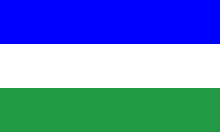Ladins
 | |
 The Ladin-speaking valleys of Val di Fassa, Val Gardena, Val Badia, Livinallongo and Ampezzo and their locations in northern Italy | |
| Total population | |
|---|---|
| ≈31,000 (2011, est.) | |
| Regions with significant populations | |
| Ladinia | |
| Languages | |
| Ladin | |
| Religion | |
| Roman Catholicism | |
| Related ethnic groups | |
| Friulians, Romansh |
The Ladins are an ethnolinguistic group[1][2] of northern Italy. They are distributed in several valleys, collectively known as Ladinia. These include the valleys: of Badia and Gherdëina in South Tyrol, of Fassa in the Trentino, and Livinallongo (also known as Buchenstein or Fodom) and Ampezzo in the Province of Belluno.[3] Their native language is Ladin, a Rhaeto-Romance language related to the Swiss Romansh and Friulian languages.[4] They are part of Tyrol, with which they share culture, history, traditions, environment and architecture.
Ladins developed a formal national identity in the 19th century.[3][5] Micurà de Rü undertook the first attempt to develop a written form of the Ladin language. Nowadays, Ladin culture is promoted by the government-sponsored cultural institute Istitut Ladin Micurà de Rü in the South Tyrolean municipality of San Martin de Tor. There is also a Ladin museum in the same municipality. The Ladins of Trentino and Belluno have their own cultural institutes: Majon de Fascegn in Vigo di Fassa, Cesa de Jan in Colle Santa Lucia and Istituto Ladin de la Dolomites in Borca di Cadore.
The Ladin people constitute only 4.53% of the population of South Tyrol.[6] Many of the South Tyrolean Sagas come from the Ladin territory, including the national epic of the Ladin people, the saga of the Kingdom of Fanes. Another figure from Ladin mythology is the demon Anguana.
Communities
[edit]
Ladin
NameItalian
NameGerman
NameProvince Area
(km2)Population Anpezo Cortina d’Ampezzo Hayden Belluno 255 6,150 Urtijëi Ortisei St. Ulrich in Gröden South Tyrol 24 4,569 Badia Badia Abtei 82 3,237 Mareo Marebbe Enneberg 161 2,684 Moéna Moena Moena Trentino 82 2,628 Sëlva Selva di Val Gardena Wolkenstein in Gröden South Tyrol 53 2,589 Poza Pozza di Fassa Potzach im Fassatal Trentino 73 1,983 Cianacei Canazei Kanzenei 67 1,844 Santa Cristina Gherdëina Santa Cristina Valgardena St. Christina in Gröden South Tyrol 31 1,840 San Martin de Tor San Martino in Badia St. Martin in Thurn 76 1,727 Fodom Livinallongo del Col di Lana Buchenstein Belluno 99 1,436 Corvara Corvara Kurfar South Tyrol 42 1,266 La Val La Valle Wengen 39 1,251 Låg Laghetti Laag 23 1,284 Vich Vigo di Fassa Vig im Fassatal Trentino 26 1,142 Ciampedèl Campitello di Fassa Kampidel im Fassatal 25 732 Sorèga Soraga Überwasser 19 677 Mazin Mazzin Mazzin 23 440 Col Colle Santa Lucia Verseil Belluno 15 418
Gallery
[edit]-
Ladin farms in La Val
-
Castle Thurn, San Martin de Tor in the 1960s
-
Tavella and Lunz in La Val in the 1960s.
-
Ploughing in La Val in the 1960s.
Notable people
[edit]- Maria Canins, Cyclist (twice winner of the Tour de France Féminin), cross-country skier (15-time national champion) and mountain runner.
- Nicol Delago, professional alpine skier
- Giorgio Moroder, singer, songwriter, DJ and record producer
- Ettore Sottsass, photographer, architect and designer
- Carolina Kostner, figure skater, 2014 Olympic bronze medalist, 2012 World champion, and five-time European champion.
- Simon Kostner, ice hockey player, represented the Italian national team in several tournaments.
- Erwin Kostner, ice hockey player, competed in the men's tournament at the 1984 Winter Olympics.
- Kristian Ghedina, World Cup alpine ski racer whose thirteen victories are the most by an Italian downhill specialist in World Cup history.
- Simona Senoner, cross-country racer and ski jumper
- Peter Runggaldier, professional Alpine skier
See also
[edit]- The Ladinian, a stage/age of the Triassic period named for the Ladin people
- Nones dialect
- Raeti
- Rhaeto-Romance
Further reading
[edit]- Tobia Moroder (Ed.): The Ladins of the Dolomites. People, landscape, culture. Vienna/Bozen: Folio 2016, ISBN 978-3-85256-697-9
References
[edit]- ^ Jan Markusse: The South Tyrolese Inter-Ethnic Package Deal. An Example for Other Multi-Ethnic Regions?, in: Yearbook of European Studies 6. Borders and Territories. Rodopi, Amsterdam/Atlanta 1993, ISBN 90-5183-506-X, p. 193-220. E. g. For the small ethnic group of Ladins the package offers advantages and disadvantages.
- ^ Christoph Perathoner: Die Dolomitenladiner 1848–1918: ethnisches Bewusstsein und politische Partizipation. Folio, Bozen/Wien 1998, ISBN 978-3852560809
- ^ a b Sakalis, Alex (22 November 2021). "Italy's Most Mysterious Region Has Warrior Princesses and a Marmot Obsession". The Daily Beast. Retrieved 10 October 2023.
- ^ [1][permanent dead link] "die drei rätoromanischen Teilgruppen (Bündnerromanisch, Dolomitenladinisch, Friaulisch) ... treten als eine vom Oberitalienischen gänzlich differenzierte Sprachfamilie auf" (the 3 reto-romance language-groups Rumanc, Dolomite Ladin and Friulan are a separate language-family from northern-Italian), 2003 by Prof. Dr. Roland Bauer, University of Salzburg
- ^ Christoph Perathoner: Die Dolomitenladiner 1848–1918: ethnisches Bewusstsein und politische Partizipation. Folio, Bozen/Wien 1998, ISBN 978-3852560809
- ^ "South Tyrol in Figures" (PDF). Declaration of language group affiliation – Population Census 2011. Retrieved 2012-10-07.
External links
[edit]- Istitut Cultural Ladin Micurà de Rü (in South Tyrol), official site
- Istitut Cultural Ladin Majon di Fascegn (in Trentino), official site
- Istitut Cultural Ladin Cesa de Jan (in Belluno province), official site




